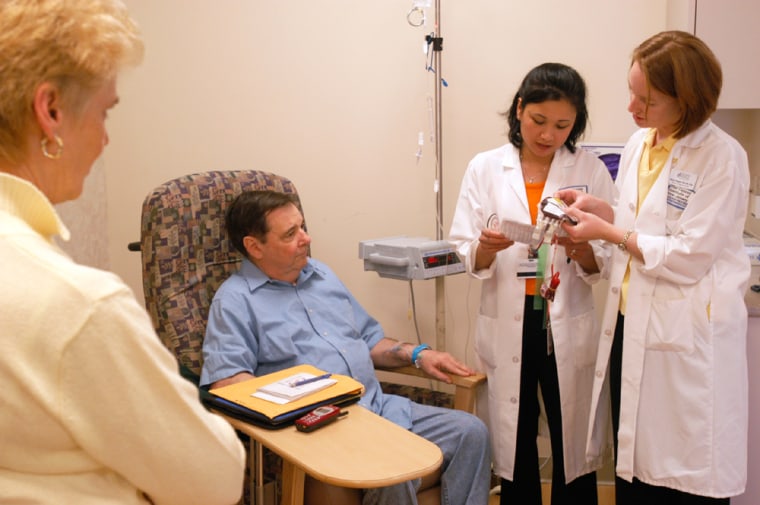The costs of cancer are staggering: Last year, the U.S. bill for direct medical costs and lost worker productivity totaled nearly $190 billion. And with the incidence of cancer expected to rise, there's a new emphasis on one way to help reduce both cases and costs — prevention.
Cancer centers are focusing more of their efforts on researching preventative measures and educating the public. Many are increasing their cancer prevention and control budgets, while others are establishing entirely new prevention centers.
“The best possible way to deal with cancer is not to have it in the first place, so the focus on prevention makes great sense,” said Dr. Robert C. Young, president of the Fox Chase Cancer Center in Philadelphia and former president of the American Cancer Society.
Once a person develops cancer, the costs of treatment — including doctor visits, hospital stays, surgeries, chemotherapy and radiation — can be enormous. While novel "targeted" drug therapies offer new hope in the war on cancer, they are pricey, sometimes costing as much as $100,000 a year. And developing new treatments costs millions.
So it's clear that finding effective strategies for preventing cancer could pay off in many ways.
“The whole energy in this area has dramatically increased from where it was some 10 or 15 years ago,” said Graham Colditz, director of the Center for Cancer Prevention at the Harvard School of Public Health in Boston.
“The growing financial burden of cancer places more pressure on us to move things along,” he said.
Cases to escalate
Among other factors, cancer cases are expected to rise because people are living longer and with bad habits.
According to the Centers for Disease Control and Prevention, cancer is poised to become the leading cause of death in the United States over the next decade, overtaking the current top killer, heart disease, and substantially adding to cancer’s financial burden. Globally, the World Health Organization estimates there will be a 50 percent rise in the number of new cancer cases by 2020.
Although doctors have lowered overall cancer death rates in the United States, they still have a long way to go to cure many patients. Once cancer has spread to other organs, a process called metastasis, survival rates plummet.
But many cancers can be prevented, health officials say. The latest American Cancer Society data show roughly a third of the 550,000 cancer deaths in the United States last year were caused by tobacco use. Another third was estimated to be tied to poor nutrition, physical inactivity, obesity and other lifestyle factors.
And experts worry that our increasingly overweight, couch-potato culture will only fuel cancer rates.
“Because obesity is rising so rapidly in the United States, it’s not rocket science to say the diseases associated with it will be going up and therefore will become added costs to the healthcare system,” Colditz said.
Prevention: The best medicine
So several cancer centers are now working harder to find ways to prevent the problem in the first place.
One of them is the Cancer Institute of New Jersey (CINJ) in New Brunswick. The state has some of the highest rates of cancer, leading the nation in the incidence of prostate cancer, non-Hodgkin's lymphoma and male colorectal cancer. Cancer accounts for one in four deaths in the state annually.
This year, the CINJ is devoting some $4 million, or about 8 percent of its annual budget, to cancer prevention efforts, which include up to nine active cancer prevention and control research projects. The center's prevention budget has increased steadily over the last few years.
Current projects include studies into the cancer-fighting properties of dietary supplements and teas, and ways to identify young women at high risk for breast cancer who might benefit from prevention measures.
Another big emphasis is on beating tobacco addiction, one of the leading causes of cancer, according to CINJ Director Dr. William N. Hait.
“It’s very hard to get people to stop smoking,” he said. “Very little solid work is done to understand smoking addiction, but we are committed to understanding how and why people get addicted to cigarettes and how we can use both behavioral and medicinal approaches to make sure people don’t get addicted.”
Funding a challenge
But like with many cancer centers around the country, funding at the CINJ is a challenge, says Chief Operating Officer Stephen Nash.
Most of the center’s revenue comes from its state appropriation from the legislature of New Jersey, with grants, fund-raising, and money from drug companies for clinical trials making up what's left.
However, there's simply not enough money to fund all the research initiatives they'd like, according to Nash.
“In the cancer control and prevention world, it’s very difficult to find money to pay for research activities,” Nash said. “[America spends] billions of dollars on treatment, but we spend only a fraction on prevention and cancer control.”
